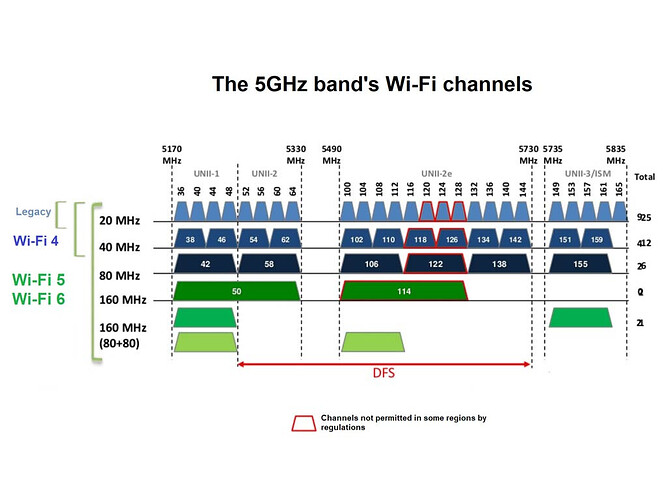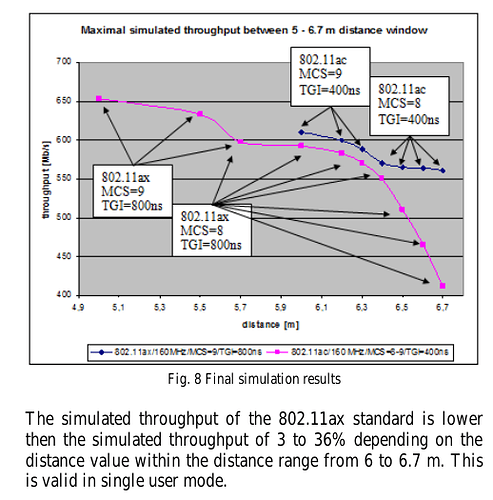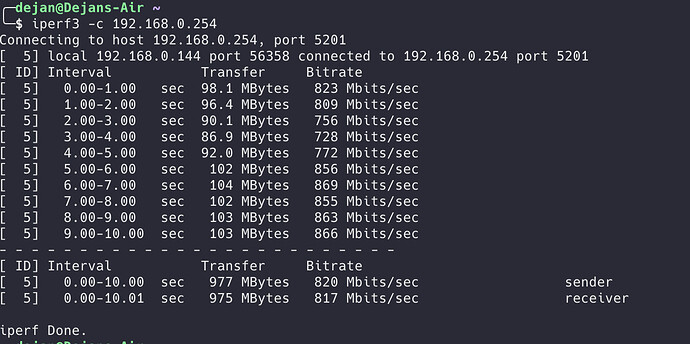there's a wall between the AP and the client, the AP is high on the ceiling, the client is on the floor in a corner, cornered by walls, 5 meters from the AP.
Try a non dfs channel - below channel 48. I'm set to 48 80hz wide, and I'm seing 800Mbps on both mac hardware and ax200.
Hmm, using channel 48 80Mhz wide crosses into DFS, doesn't it?
I also have neighbors nearby in channels 36-48.
In the middle of the woods in the Scottish Highlands I see 'netsh wlan show interfaces' report:
receive rate (Mbps): 1081
transmit rate (Mbps): 1134,
but the actual transfer rate over iperf3 about 1 metre from my RT3200 is around 350 to 400 Mbit/s between the RT3200 and my laptop.
This is on 5Ghz channel 36 with 80Mhz width.
This is with an Intel(R) Wi-Fi 6 AX201 160Mhz card in my Acer laptop.
But interestingly I see circa 800Mbit/s between 2x RT3200's connected via WDS.
What does this tell us I wonder?
It could be: RT3200 can be 4x4, whereas an AX201 is only 2x2. That would account for most of it, especially if the wireless bridge is bridging a wired connection, and not acting as a wifi repeater on 5GHz.
giuliomagnifico made some measurements and compared the wax202 and R7800.
Findings include that with current state of the drivers and on this specific hardware, walls and distance strongly degrade throughput of 802.11ax as compared to 802.11ac
The question is, if hardware is the culprit, drivers or rather the ax protocol.
I was trying to do some digging and found a scientific article that compared the ac and ax protocol with regard to throughput and distance using a theoretical model. Unfortunately the article is from 2018, but the result predict these real-world measurements and suggest the protocol is "at fault".
The formula employed is this:
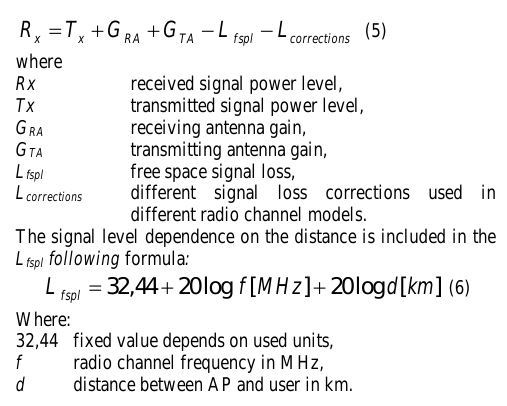
which results in examples for simulated throughput similar to:
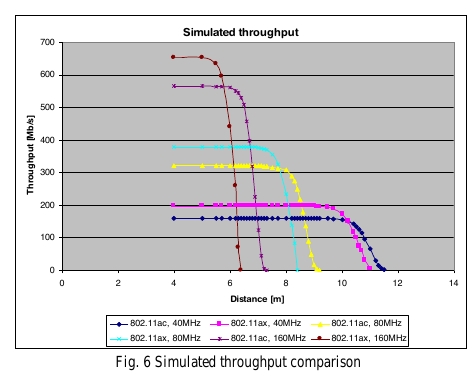
They conclude, the ac standard can outperform ax in certain ranges.
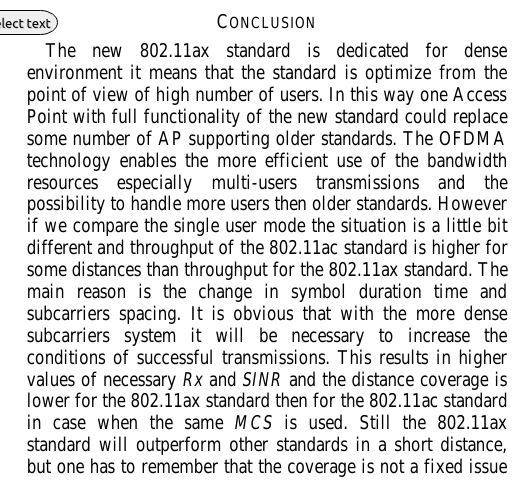
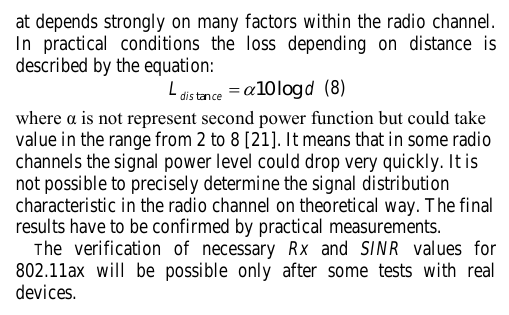
- Source; DOI: 10.24425/ijet.2019.126286
To be honest, I would be fine with lower throughput, as long as latency and ping is also low and there is an absence of connection loss...
In short, I would be fine with Stability > throughput
I wonder if ax is better in that regard.
I wonder if this means in the middle of the woods we should use AC not AX?
I guess it depends. If you have many devices you definitely could try ax. If you are close to the AP or Router, ax seems fine too.
Also, we have not seen a lot of measurements showing comparisons of latency and ping, so in that regard, we don't know.
On another note, as far as I am aware, ax also can be used for 2.4 GHz, whereas ac only for 5GHz. 2.4 GHz reaches further distances than 5GHz, therefore ax on 2.4GHz could potentially be better than ac on 5GHz in those very edgy long distance ranges, right?
I tried again few hours ago with the default Netgear drivers but the speed from my desk is always 150/200mbps less than the R7800.
About the latency, this also interest me more than the speed but is difficult to test with iperf because you need a perfect syncing of the clock of both client and server. I have no idea how to do.
Yes you can do a simply test for jitter/bufferbloat but it’s not accurate, very empirical.
You can add these WiFi 6 (AX) options and retest.
Add these options in the "wireless" file on the WiFi 5/6 GHz device/radio and then reboot the router:
option he_bss_color '8'
option he_su_beamformee '1'
It is recommended to set the BSS coloring to "8" and enable this beamforming option for Wi-Fi 6 (AX) to work correctly, because it is not enabled by default in OpenWrt and several people in that thread say that adding those options improved their WiFi 6 (AX) connection:
WiFi 5 (AC) beamforming options enabled by default in OpenWrt:
WiFi 6 (AX) beamforming options enabled by default in OpenWrt:
⠀
P.S. Also check which is the best channel with the maximum transmission power in your country to use in the 5/6 GHz WiFi radio with this command: iw phy
Ok, this is better. I set the options as described, rebooted, and set the RT3200 to run with AX. I'm now getting around 480 Mbits/sec on iperf3 with an Intel AX210 client
Fantastic finds! So OpenWrt defaults are at fault and need changing? How do we achieve that?
Supposedly the bs color option was added and should be auto enabled for AX here:
https://github.com/openwrt/openwrt/commit/6c152ce5b0c003099dc1d9076fc3c38d061c1137
Works great thanks!
For those looking to try it out:
$ vi /etc/config/wireless
Add those options under config wifi-device 'radio1'
$ wifi reload radio1 #reload that radio without reboot
Interesting find. I do not see a difference in throughout (iperf3) but maybe distance which I have not tested.
I’ve tried “he_bss_color” and “he_su_beamformee” and the iPhone upload still crawls at 10Mbps with 802.11ax and a wall between the phone and access point. Changing to 802.11ac works fine.
@daniel - Can you comment on manually adding these on an RT3200?
Curiously when I set to channel 100 I see full power (26.0 dBm) on main router, but on secondary WDS-connected devices I only see 23.0 dBm. Does acting as a WDS client force lower power or is this a bug?
So on all 3x RT3200's I see:
- 5500 MHz [100] (26.0 dBm) (radar detection)
But then only the WDS AP gets set to 26.0 dBm and the WDS clients will only go to 23.0 dBm? What's with this?
I see in 'dmesg':
wlan1: Limiting TX power to 23 (26 - 3) dBm as advertised by
This extra "-3 dBm" is not specific to WDS and not specific to 802.11ax, and not even specific to mt76. I have a similar line in dmesg when my desktop (with an mt76 WiFi card) connects as a client to an AP provided by TP-Link Archer C7, too.
